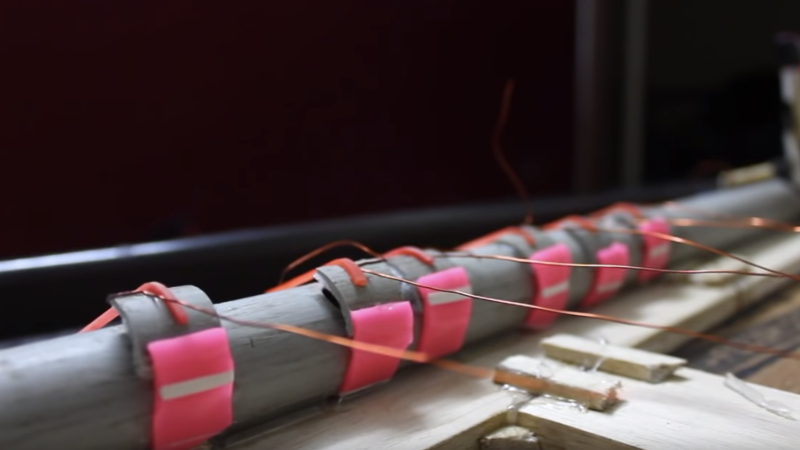It’s one thing to be able to transcribe music from a flute, and it’s another to be able to make a flute play pre-written music. The latter is what [Abhilash Patel] decided to pursue in the flute player machine, an Arduino-based project that uses an air flow mechanism and PVC pipes to control the notes produced by a makeshift flute. It’s currently able to play 17 notes, just over two octaves starting from the lowest frequency of E.
In order to play songs, the tones have to either be directly coded and uploaded to the Arduino, composed with a random note generator, or detected from a microphone. While a real flute can be used for the machine, [Patel] uses a PVC flute, constructed with some knowledge of flute playing.
The resonant frequency is based on the effective length, hole sizes, and pipe diameter, so it is fairly difficult to correctly tune a homemade flute. Nevertheless, calculating the length as c/2f where c is the speed of sound (~345 m/s) and f is the frequency of the note can help with identifying the location of the holes. [Patel] cut the PVC pipe and sealed off one end, drilling a blowing hole at 1.5 x the pipe diameter. After playing the flute, the end of the pipe was filled until the frequency exactly matched the desired note.
The hole covering uses cuttings of pipe attached to a cable connecting to a servo. The motors are isolated inside a box to keep the wires clear and area all able to be powered with 5 V. As for the software, the code is primarily used to control when the fan is blowing and which holes are covered to produce a note.
Listen to the flute play “My Heart Will Go On” from Titanic in the video below. Now the next step might just be making the flute playing machine automatically play sheet music – imagine the possibilities!
















He drilled a hole that was 1.5 times larger than the pipe he was drilling into? Sounds difficult.
According to the linked instructable, he drilled a blow-hole at a distance from the end- that distance was 1.5x the pipe’s diameter.
Made me think of https://youtube.com/watch?v=KolfEhV-KiA :)
I thought of https://www.youtube.com/watch?v=akEXWdOBDHE
(great work, [Abhilash Patel] !!)
It works well enough for a slow piece. Pick up the pace, add some trills, and does it still work?
Try a little Jethro Tull: https://youtu.be/EsCyC1dZiN8?t=24
Sure, is doable, https://www.youtube.com/watch?v=HmSYnOvEueo
with that setup trills are out of the question (i know that’s what you meant, but i plan to add something serious afterwards, so i need to deconstruct the joke first). the servos are simply too slow.
however, that problem can somehow be engineered away. if i think about how valves move in a car engine, i am pretty confident something can be done for a flute.
what is a lot harder, is engineering the tongue of the player into the system. granted, ian anderson from jethro tull does weird things with his tongue and voice when he plays at times here and there, but that’s not what i mean.
at minimum, you need something before the airsupply-flute interface that can articulate the consonant T. some sort of valve that could block the air flow, create some higher than normal pressure, and release it suddenly, but with limited airflow.
then we can talk further.
Very nice! It would be fun to adapt this to real-time MIDI control.
Neat concept, though I feel like it looses some of the expression and dynamics that you’d get from playing live. It’d be interesting to see if they could come up with a way to imitate that, or at least get a close approximation.